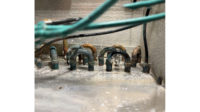While servicing new reach-in coolers and freezers today, technicians will likely find these systems are using R-290 (propane) as the refrigerant. R-290 is a hydrocarbon (HC) refrigerant and is classified A3 by ASHRAE Standard 34, which means it is a refrigerant with a low toxicity rating but highly flammable. Working on systems using HC refrigerants is not tremendously difficult, but it does require some different servicing procedures.
Repairing refrigerant leaks on these systems is one of the servicing procedures that requires a slightly different approach. R-290 is highly flammable, so there are several safety procedures that need to be followed. Although the maximum charge allowed today is only 150 grams (5.3 ounces) — and many systems will use less than the maximum charge — this small amount can still ignite and present a serious safety issue for technicians and their customers.
One of the concerns while working around R-290 equipment is that a release of refrigerant cannot be sensed by smell. Many other flammable gases used in the HVACR industry (e.g., natural gas, fuel grade propane) have an odorant added to the fuel to aid in the detection of the gas. R-290 does not have any odorants added when used as a refrigerant, so it is not possible to smell its presence in the surrounding atmospheric air.
Leak searching these systems requires techniques that allow for a safe and efficient method of finding the source of the leak. Some traditional methods that can be used safely are soap bubbles and manufacturer-approved dyes. An electronic leak detector approved for HC refrigerants can also be used, as well as a standard ultrasonic leak detector.
While repairing these systems, if there is refrigerant in the system that needs to be removed before repairing the leak or replacing the failed component, it can be vented into the atmosphere. The Environmental Protection Agency (EPA) does not require this refrigerant to be recovered; however, it does need to be vented safely. The current recommendation is to vent the refrigerant to the outdoors, which can be done by either moving the equipment outdoors or using a hose to vent the refrigerant to the outdoors.
Venting outdoors is not always practical or possible, so another option is to use an approved HC recovery tank. Evacuate the tank to about 1,000 microns and allow the vacuum to pull the remaining refrigerant into the tank. Since the system contains only a very small amount of refrigerant, the vacuum within the tank should be able to remove the remaining refrigerant from the system. The recovery tank can then be moved outside and the refrigerant vented to the outdoor atmosphere.
Brazing is another concern on these systems. If some refrigerant remains in the system, it could be ignited by the torch flame. Today there are several options available to use a pressed fitting to repair or replace components, so if this option is available, it would allow for the repair to be made without using a torch. Again, if this is not a viable or good option technicians will need to use a torch to repair the leak or replace the component.
If there is a need to braze, then the current recommendation is to first purge the system with nitrogen, then evacuate the system, and then sweep nitrogen through the system while brazing. Also have a Class B dry powder or CO2-type fire extinguisher available; this is not unique to R-290 but always a good practice to follow when using an open flame on a system.
Again, working on R-290 systems is not difficult, but some common sense and some additional safety procedures are needed to ensure a safe working environment for technicians and their customers.







